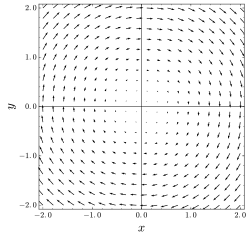



Invector calculusasolenoidal vector field (also known as an incompressible vector field, a divergence-free vector field, or a transverse vector field) is a vector field v with divergence zero at all points in the field:

The divergence theorem gives an equivalent integral definition of a solenoidal field; namely that for any closed surface, the net total flux through the surface must be zero:

where 
The fundamental theorem of vector calculus states that any vector field can be expressed as the sum of an irrotational and a solenoidal field. The condition of zero divergence is satisfied whenever a vector field v has only a vector potential component, because the definition of the vector potential A as:
 automatically results in the identity (as can be shown, for example, using Cartesian coordinates):
automatically results in the identity (as can be shown, for example, using Cartesian coordinates):
 The converse also holds: for any solenoidal v there exists a vector potential A such that
The converse also holds: for any solenoidal v there exists a vector potential A such that  (Strictly speaking, this holds subject to certain technical conditions on v, see Helmholtz decomposition.)
(Strictly speaking, this holds subject to certain technical conditions on v, see Helmholtz decomposition.)
Solenoidal has its origin in the Greek word for solenoid, which is σωληνοειδές (sōlēnoeidēs) meaning pipe-shaped, from σωλην (sōlēn) or pipe.
 );
); .
.